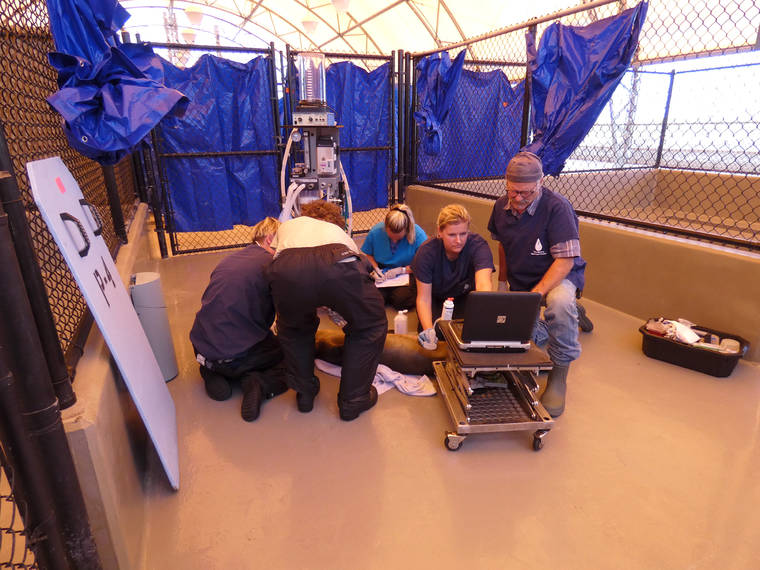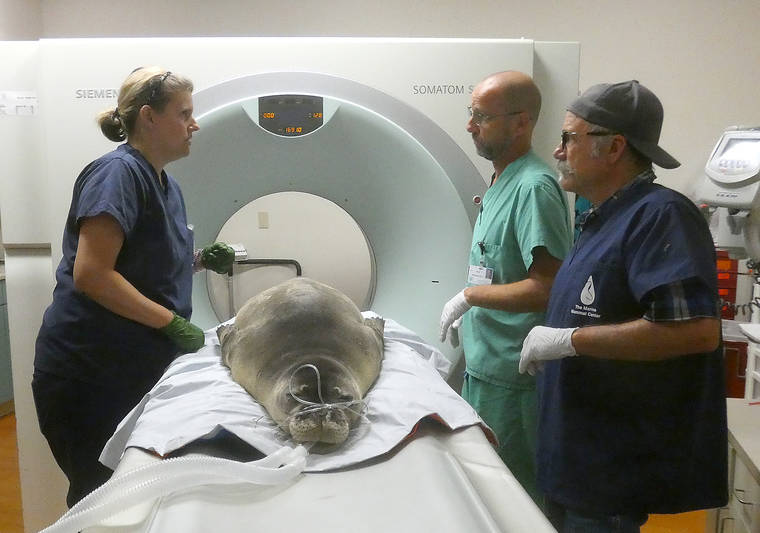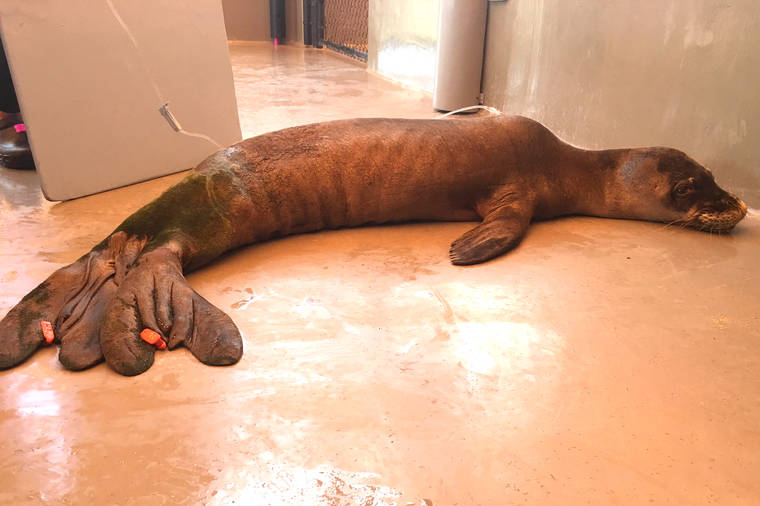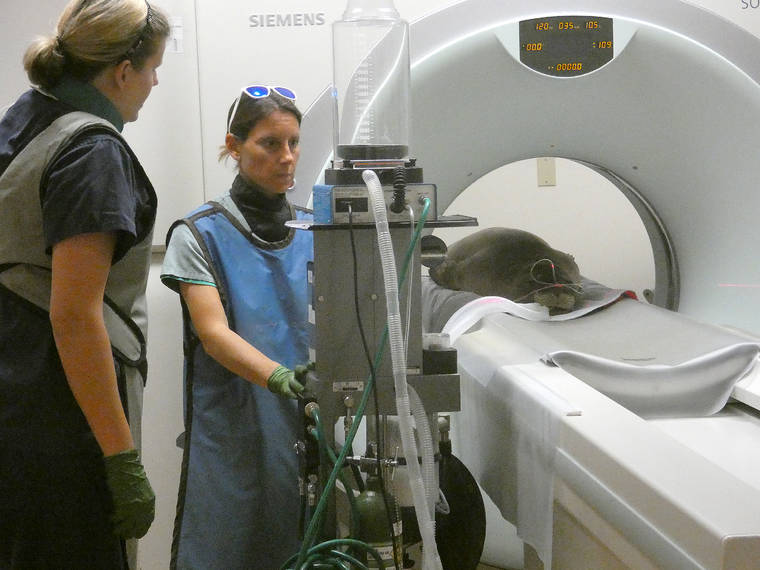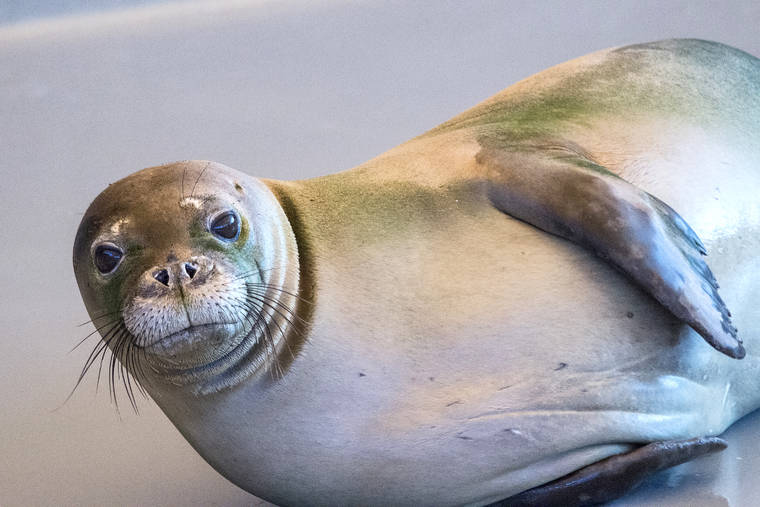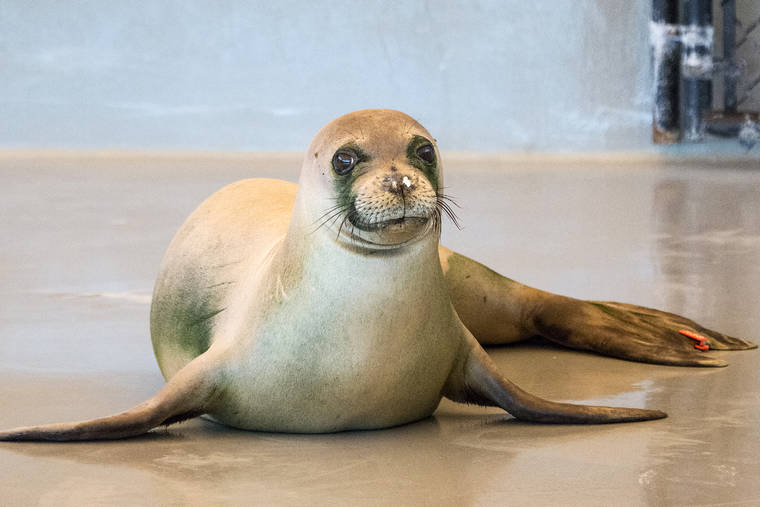KAILUA-KONA — A Hawaiian monk seal that underwent a CT scan last month at a Waimea hospital is stable, but remains in critical condition.
RH 38’s CT scan performed April 21 at North Hawaii Community Hospital showed the 3.5-year-old endangered mammal was suffering muscle inflammation and infection in her back flippers, which spread to her bloodstream and caused a wide range of other problems, according to The Marine Mammal Center.
Based on the location and extent of the muscle damage, veterinarians suspect trauma as the initial cause of the injury, though the source is unknown.
“Wild animals mask pain and injury, so internal injuries can be well hidden, unlike more obvious external wounds,” said Dr. Claire Simeone, The Marine Mammal Center’s hospital director at Ke Kai Ola Hawaiian Monk Seal Hospital, said in a press release. “We’re elated to discover the diagnosis for this complex case, as each individual is critical to restoring this endangered population.”
On Thursday, the center said RH38 is stable, but remains in critical condition at the Kailua-Kona facility where she’s been receiving care since March 12. The monk seal is currently receiving antibiotics, pain medications and laser therapy.
The center added veterinarians are optimistic that RH38 will continue to improve.
It’s unknown whether the trauma that caused her injury was natural or human-induced, according to the center, which also noted it’s currently unclear whether it the injuries were intentionally or accidentally inflicted.
Monk seals can suffer trauma during interactions with predators or other seals or from a variety of hazards, including debris in heavy surf and eroding rocks along shorelines where seals haul-out to rest, the center said. Accidental sources of trauma can include a boat strike or vehicle injury.
While rare, the center noted there have been confirmed cases of intentional trauma inflicted on seals by people.
“We always ask residents and visitors state-wide to be aware of seals that are or might be hauled out on beaches, for the safety of people and seals,” said Simeone. “We encourage beachgoers to share space with marine wildlife and report any interactions, whether accidental or intentional, so that responders can quickly assess the affected animal.”
RH38 was taken to the monk seal hospital March 12 after she began to rapidly lose body condition. The Kauai Hawaiian Monk Seal Conservation Hui had monitored the over the past year and routinely observed her in good body condition until this spring.
On April 21, the monk seal underwent a CT scan at North Hawaii Community Hospital. It marked two firsts: the first CT scan ever conducted on a wild Hawaiian monk seal and the hospital’s first nonhuman patient.
The scan of the seal’s entire body — from nose to flipper — allowed veterinarians to more closely investigate the different organ systems that were showing signs of damage and pinpoint the source.
At the time of her rescue, RH38 was molting, a natural annual process during which monk seals shed their hair and skin. Veterinarians suspect that some aspect of immunosuppression related to her molt may have played a role in her inability to deal with the infection caused by the trauma.
During her time at Ke Kai Ola, the monk seal been successfully treated for pneumonia and corneal damage, both of which have resolved, according to the center. She also developed a skin infection, kidney infection, resulting kidney stones and a liver infection, all of which are being treated.
RH38’s current admittance at Ke Kai Ola isn’t her first. The seal was admitted to the hospital in August 2017 for malnutrition and a heavy parasite load. During her three-month stay, RH38 more than doubled in body weight and was successfully released back to Kauai.
Her current condition is not thought to be related to her original admit in 2017.
The Marine Mammal Center has rehabilitated 27 monk seals since opening Ke Kai Ola in 2014, the majority of which were rescued from and returned to the Northwestern Hawaiian Islands.
NOAA researchers estimate the current monk seal population to be about 1,400 animals, and about 30 percent of those monk seals are alive today directly due to conservation efforts led by NOAA and its partners. About 300 live in the Main Hawaiian Islands; a handful reside in waters off Hawaii Island.
As always, members of the public should keep a safe distance from monk seals and report sightings on Hawaii Island to the The Marine Mammal Center’s local response team at the 24-hour hotline by calling (808) 987-0765.
Volunteers are also needed at the Kona hospital and visitor center in a variety of roles, including animal care, education and response. Visit www.marinemammalcenter.org/kko-volunteer for more information.







